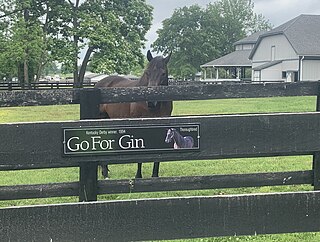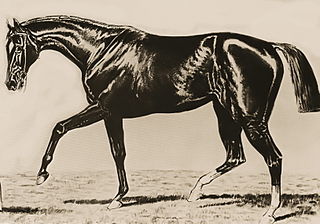
Northern Dancer was a Thoroughbred that, in 1964, became the first Canadian-bred horse to win the Kentucky Derby. After being retired from racing, he became one of the most successful sires of the 20th century. He is considered a Canadian icon and was inducted into the Canadian Sports Hall of Fame in 1965. Induction into the Racing Hall of Fame in both Canada and the United States followed in 1976. As a competitor, The Blood-Horse ranked him as one of the top 100 U.S. Thoroughbred racehorses of the 20th century. As a sire of sires, his influence on the breed is still felt worldwide.

Mr. Prospector was a Thoroughbred racehorse who became an outstanding breeding stallion and notable sire of sires. A sprinter whose career was cut short by repeated injuries, he won seven of his 14 starts, including the Gravesend Handicap at Aqueduct Racetrack and the Whirlaway Handicap at Garden State Park.
Flower Alley is an American Thoroughbred racehorse and sire. Winner of the Travers Stakes during his racing career, he is best known as the sire of 2012 Kentucky Derby and Preakness Stakes winner I'll Have Another.

Lexington was a United States Thoroughbred race horse who won six of his seven race starts. Perhaps his greatest fame, however, came as the most successful sire of the second half of the nineteenth century; he was the leading sire in North America 16 times, and broodmare sire of many notable racehorses.
Blue Larkspur (1926–1947) was a bay Kentucky-bred thoroughbred race horse. He was inducted into the National Museum of Racing and Hall of Fame in 1957, and ranks Number 100 in The Blood-Horse's top 100 U.S. thoroughbred champions of the 20th Century. Of the 127 stakes winners bred by Colonel Edward Riley Bradley at his Idle Hour Stock Farm in Lexington, Kentucky – which includes Bimelech out of La Troienne – Blue Larkspur was considered the Colonel's finest horse.

Diomed (1777–1808) was an English Thoroughbred race horse who won the inaugural running of the Epsom Derby in 1780. Sold and imported to Virginia, he was subsequently a successful sire in the United States after the American Revolutionary War.

Sea Hero was an American-bred Thoroughbred racehorse best known for winning the 1993 Kentucky Derby and Travers Stakes. Beginning in 2011, Sea Hero was the oldest living winner of the Kentucky Derby until his death in 2019.

Woodburn Stud was an American horse breeding farm located in Woodford County, Kentucky about ten miles (16 km) from the city of Lexington. It was established in the 18th century as an original land grant property of General Hugh Mercer to whom it had been granted for his military services during the American Revolutionary War. Robert Alexander (1767–1841), a Scottish immigrant, came to Virginia from Scotland in 1786. Around 1790 he purchased the Mercer estate in Kentucky. Under the guidance of his son, Robert A. Alexander, during the 19th century, Woodburn Stud became the birthplace of Kentucky's Thoroughbred industry.
Danzig was an American Thoroughbred racehorse who is best known as a leading sire. He was purchased for $310,000 by Henryk de Kwiatkowski at the 1978 Saratoga Yearling Sale. The son of Hall of Famer Northern Dancer and the most commercially successful sire of the second half of the 20th century, he won all three of his races before knee problems ended his racing career.

Go for Gin was an American thoroughbred racehorse best known as the winner of the 1994 Kentucky Derby. He was sired by Cormorant out of the dam Never Knock. He was ridden in the Derby by Chris McCarron, who had previously won the race on Alysheba.

Spendthrift was a successful American Thoroughbred racehorse and an outstanding sire.

Kentucky (1861–1875), was a successful American Thoroughbred racehorse who won 21 of his 23 starts, including 20 consecutive wins.
Macbeth II was a horse who was the winner of the 1888 Kentucky Derby He was the third gelding and one of only nine geldings to win the Kentucky Derby, with the others being Vagrant (1876), Apollo (1882), Old Rosebud (1914), Exterminator (1918), Paul Jones (1920), Clyde Van Dusen (1929), Funny Cide (2003), and Mine That Bird (2009).

His Eminence was an American Thoroughbred racehorse that was bred in Kentucky and is best known for winning the 1901 Kentucky Derby. He was a bay colt sired by the great turf-racer Falsetto out of the mare Patroness. His dam was sold to Overton H. Chenault at the 1897 Woodburn Stud dispersal sale for $75. As a yearling, he was sold to J. B. Lewman for $500[1].

Falsetto (1876–1904) was an American Thoroughbred Champion racehorse and outstanding sire. Bred and raced by J. W. Hunt Reynolds of Lexington, Kentucky, his dam was Farfaletta and his sire was General Abe Buford's very good runner, Enquirer.

Harry Bassett (1868–1878) was an American Thoroughbred racehorse, winner of the 1871 Belmont Stakes and an outstanding racehorse of the 19th century. He also won a number of other stakes races, and was named the Champion male of his age group in 1870, 1871 and 1872. He was retired to stud duties in New Jersey when his five-year racing career ended, having recorded 23 wins from 36 starts. Harry Bassett died in New Jersey in 1878 and was inducted into the United States Racing Hall of Fame in 2010.

Eleanor was a British Thoroughbred racehorse bred by Charles Bunbury and was the first female horse to win The Derby. Eleanor also won the 1801 Epsom Oaks among many other races before retiring from racing at age eight to become a broodmare for Bunbury. She produced the stallion Muley, which in turn sired the mare Marpessa and the influential stallion Leviathan which was exported to the United States in the early nineteenth century. Through the produce of her daughter Active, Eleanor is present in the pedigrees of 19th-century American Standardbred racehorses.
Brody's Cause is an American Thoroughbred racehorse. He has won Grade I races at two and three years of age and was regarded as a contender for the 2016 Kentucky Derby. After finishing unplaced on his debut he won a maiden race and then took the Grade I Breeders' Futurity Stakes before finishing third in the Breeders' Cup Juvenile. In 2016 he ran poorly in the Tampa Bay Derby before taking the Blue Grass Stakes.
Australian was a British-bred Thoroughbred racehorse and sire. He was exported to the United States where he had modest success as a racehorse but became a very successful and influential breeding stallion.
Burlington was an American Thoroughbred racehorse best known for winning the 1890 Belmont Stakes.













